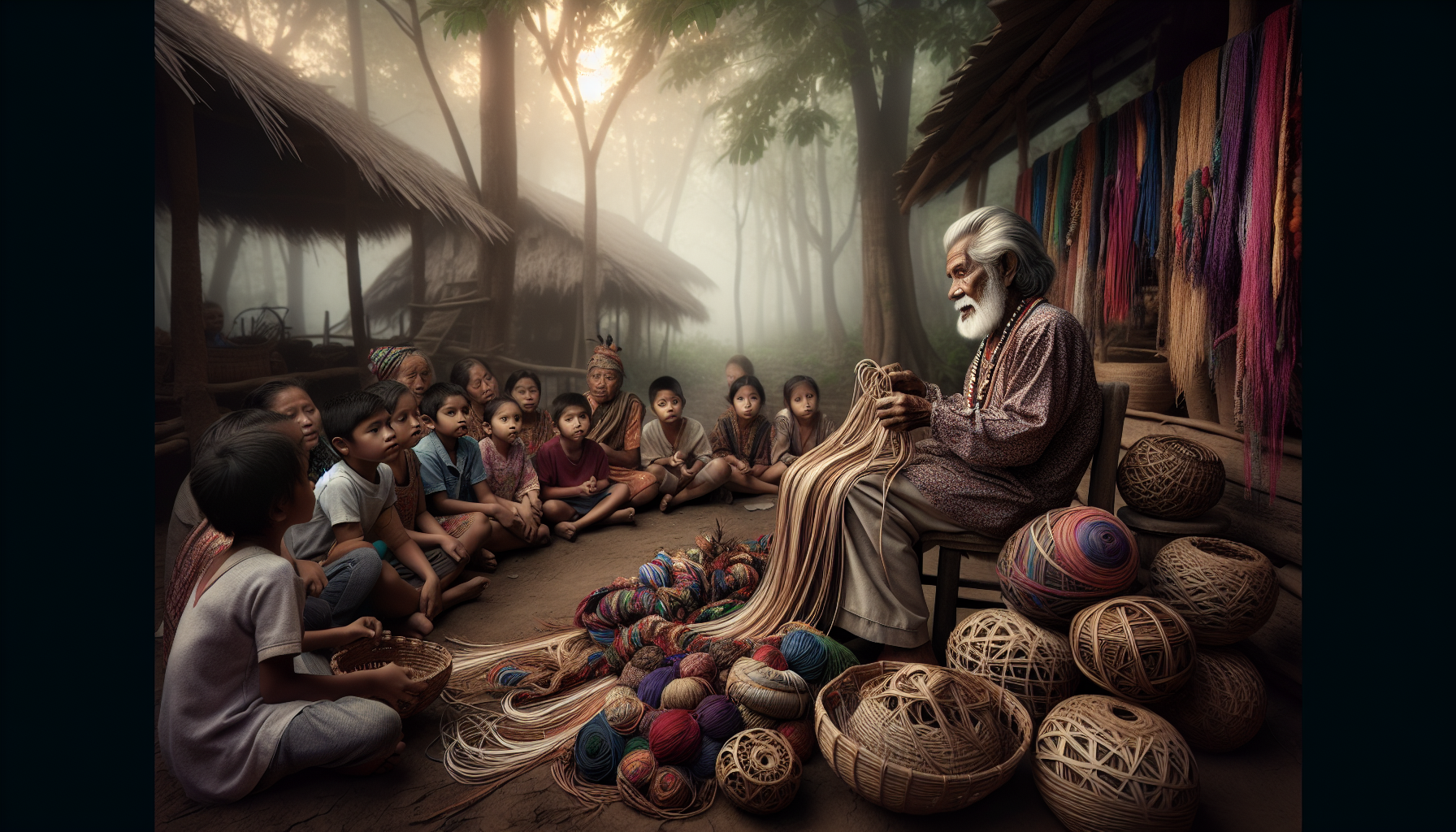Basket weaving is an ancient craft that intricately intertwines with the history of human civilization. 🧺 Imagine a time when the world was devoid of modern conveniences, and yet, human creativity flourished, leading to the birth of various art forms that were both utilitarian and deeply symbolic. Among these, basket weaving stands out as a testament to human ingenuity and cultural expression. As we unravel the history of this age-old craft, we embark on a journey that spans continents and centuries, revealing not only the evolution of techniques and materials but also the rich tapestry of stories and traditions that these humble objects hold. From the intricate patterns of Native American tribes to the vibrant colors of African baskets, each weave tells a story, each knot holds a memory. This article delves into the fascinating world of basket weaving, exploring how this craft has been a vital thread in the fabric of storytelling across different cultures.
As we delve deeper into this intricate art, we’ll explore the varied techniques that have been passed down through generations. Basket weaving is far more than a simple craft; it is an embodiment of cultural heritage and an important vehicle for storytelling. Each region has developed its unique style, using materials that are indigenous to their environment. For example, the bamboo baskets of Asia are a testament to the resourcefulness and artistry of their creators, while the sweetgrass baskets of the Gullah people in South Carolina are a poignant reminder of the African traditions carried over by enslaved peoples. By examining these distinct styles and the materials used, we gain insights into the geographical and historical contexts that shaped them. Furthermore, we’ll discuss how basket weaving has adapted to the modern era, finding its place in contemporary art and sustainable practices.
Our journey will not be limited to the craft itself but will also extend to the stories that these baskets carry within their woven walls. Storytelling through basketry is an art that has been used to pass down legends, cultural values, and communal histories. Whether through symbolic designs or the narratives shared during the creation process, baskets have served as vessels of memory and identity. We’ll delve into specific examples where basketry has played a crucial role in preserving cultural narratives, from the intricate patterns of the Hopi people that depict their cosmology to the vibrant, colorful baskets of Rwanda that tell tales of peace and unity. This exploration will illuminate how basket weaving is not only an artistic endeavor but also a powerful tool for cultural preservation and storytelling. Join us as we unravel the intertwined history of basket weaving and storytelling, discovering the profound connections between craft, culture, and community. 🌍
The Rich Tradition of Basket Weaving
Basket weaving is one of the oldest crafts in human history, deeply rooted in various cultures around the world. It is an art form that blends functionality with storytelling, often reflecting the cultural and historical context of its origin. The earliest baskets discovered date back over 10,000 years, indicating the importance of this craft in human evolution. From ancient Egypt to the Indigenous tribes of North America, basket weaving has been a crucial aspect of daily life and cultural expression.
In many societies, baskets were not merely utilitarian objects but also carried symbolic meanings. They were often used in rituals and ceremonies, symbolizing fertility, abundance, and community ties. The materials and techniques used in basket weaving vary significantly across regions, influenced by the available natural resources and cultural practices. In Africa, for example, baskets are often woven from grasses and palm leaves, while in Asia, bamboo is a popular choice due to its abundance and flexibility.
The patterns and designs on baskets tell stories of the weavers and their communities. Each weave, color, and shape can represent a narrative, whether it’s a personal story, a community legend, or a historical event. This intricate storytelling through patterns is a unique aspect of basket weaving that has been passed down through generations, ensuring that each basket carries a piece of history. 🎨
Techniques and Materials in Basket Weaving
The art of basket weaving requires a deep understanding of materials and techniques, which vary widely depending on the cultural context and natural environment. The choice of materials is often dictated by what is readily available in the weaver’s environment. Common materials include reeds, grasses, bamboo, willow, and rattan. Each material offers different properties, such as flexibility, strength, and color, influencing the design and functionality of the basket.
One of the most common techniques is the coiling method, which involves spiraling bundles of materials together and stitching them in place. This method is prevalent in regions where flexible fibers are available. Another popular technique is twining, where two or more warp elements are twisted around weft elements, creating intricate patterns. In contrast, wickerwork involves weaving the weft material over and under stationary warp rods, a technique that is often used for creating sturdy baskets.
Each technique requires a specific set of skills and knowledge, often passed down through generations. Mastering these techniques allows weavers to create baskets that are not only functional but also aesthetically pleasing. The following table compares some of the most popular basket weaving techniques and their characteristics:
| Technique | Materials Used | Characteristics |
|---|---|---|
| Coiling | Grasses, Pine Needles, Raffia | Flexible, Intricate Patterns |
| Twining | Willow, Reed, Bamboo | Textured, Durable |
| Wickerwork | Rattan, Willow, Cane | Sturdy, Simple Patterns |
Understanding these techniques can enhance appreciation for the craftsmanship involved in basket weaving. Whether you’re a beginner or an experienced weaver, exploring different methods can provide valuable insights into this timeless art form.
The Role of Basket Weaving in Storytelling
Basket weaving is not only an artistic expression but also a medium for storytelling. In many cultures, the patterns and designs on baskets are imbued with meaning, often conveying stories of ancestry, mythology, or significant life events. This practice transforms baskets into vessels of cultural heritage, preserving narratives for future generations.
For Indigenous communities, basket weaving serves as a link to their ancestors, with each piece telling a story about their way of life, beliefs, and history. These narratives can be deeply personal or communal, reflecting the shared experiences of a community. In Native American cultures, for example, baskets often feature motifs representing natural elements, such as mountains, rivers, and animals, symbolizing the interconnectedness of all living things.
The symbolism in basket designs is not limited to Indigenous communities. In Japan, the art of Ikebana basket weaving incorporates Zen principles, with each element of the design representing harmony, balance, and simplicity. This approach to basket weaving transforms the craft into a form of meditation, where the process of creation becomes a reflection of the weaver’s inner state.
The Influence of Modern Basket Weaving
As societies evolve, so does the art of basket weaving. Modern weavers often experiment with new materials and techniques, blending traditional methods with contemporary design. This innovation allows the craft to remain relevant in a rapidly changing world, attracting new generations of artisans and enthusiasts.
Some contemporary weavers incorporate recycled materials into their designs, promoting sustainability and environmental consciousness. This approach not only preserves the craft but also addresses current global issues, making basket weaving a powerful tool for change. The following video provides a glimpse into the modern world of basket weaving and its impact on art and sustainability. Watch and be inspired:
Basket Weaving in the Modern World – Channel Name
By exploring the intersection of tradition and innovation, basket weaving continues to be a dynamic and evolving art form. Whether preserving cultural heritage or inspiring new artistic expressions, the craft remains a testament to human creativity and resilience.
Basket Weaving: A Global Perspective
While basket weaving is a universal craft, each culture has developed its unique style, influenced by local traditions, materials, and needs. This global diversity is what makes basket weaving a fascinating subject of study, revealing the interconnectedness and individuality of human cultures.
In Africa, basket weaving is an integral part of many communities, with each region boasting distinct styles and techniques. The Zulu people of South Africa, for example, are renowned for their intricately woven baskets, characterized by vibrant colors and geometric patterns. These baskets often serve as both functional objects and works of art, symbolizing the weaver’s skill and creativity.
In contrast, Scandinavian countries have a tradition of weaving baskets from birch bark, reflecting their abundant natural resources. These baskets are typically minimalist in design, emphasizing functionality and simplicity, yet they hold a timeless elegance that has made them popular worldwide. The following list highlights some of the most distinctive regional styles of basket weaving:
- African Baskets: Known for vibrant colors and patterns, often used in traditional ceremonies.
- Japanese Ikebana: Incorporates Zen principles, focusing on harmony and balance.
- Native American Baskets: Features motifs of natural elements, reflecting cultural narratives.
- Scandinavian Birch Baskets: Emphasizes simplicity and functionality, using natural materials.
Understanding these regional differences enriches our appreciation of basket weaving as a global art form. It highlights the diverse ways in which cultures have adapted this craft to their environment and societal needs, creating a rich tapestry of human expression.

Conclusion
As we reach the end of our exploration into the rich tapestry of basket weaving and storytelling, it’s clear that these ancient practices hold more than just historical significance. They are a testament to human creativity, resilience, and the enduring power of cultural expression. Throughout this article, we’ve journeyed through the intricate art of basket weaving, uncovering its technical aspects, cultural importance, and the stories it weaves into the fabric of communities.
We began by delving into the historical roots of basket weaving, tracing its origins to prehistoric times. Basket weaving is not just an art form; it’s a skill passed down through generations, each iteration telling a story of adaptation and survival. The materials and techniques vary across cultures, showcasing a beautiful diversity in method and style. From the sturdy baskets of the Native Americans, made with materials like willow and sweetgrass, to the intricate designs of the African Zulu baskets, each piece serves as a testament to the ingenuity and resourcefulness of its creators.
Our exploration took us further into the realm of storytelling, an equally ancient and profound tradition. Storytelling is the heart of human connection, a way to pass down wisdom, entertain, and instill values. When combined with the tactile art of basket weaving, storytelling becomes a multisensory experience, offering a tangible connection to the past. The narratives woven into baskets often speak of everyday life, spiritual beliefs, and historical events, creating a living archive of human experience.
The cultural significance of these practices cannot be overstated. In many communities, basket weaving and storytelling are not merely hobbies; they are essential components of cultural identity. They offer a sense of belonging and continuity, especially in a rapidly changing world. This connection to tradition provides a grounding force, a reminder of one’s roots and the stories that shape us.
We also explored the modern relevance of basket weaving and storytelling. In today’s fast-paced, digital world, these ancient practices offer a refuge—a chance to slow down, engage with the physical world, and connect with others on a deeper level. They encourage mindfulness and creativity, serving as a reminder of the beauty found in simplicity and craftsmanship.
Moreover, basket weaving and storytelling have found new life in contemporary art and design. Artists and designers draw inspiration from traditional techniques, infusing them with modern aesthetics and purposes. This fusion not only keeps the traditions alive but also introduces them to new audiences, ensuring their survival for future generations.
The environmental aspect of basket weaving is also worth noting. Many traditional weaving practices use sustainable materials, promoting an eco-friendly approach to art and craft. In a time when environmental consciousness is paramount, the lessons learned from these practices are more relevant than ever.
In conclusion, the art of basket weaving and storytelling is a vibrant and essential thread in the tapestry of human culture. It reminds us of where we come from, celebrates our diverse heritage, and inspires us to carry these traditions forward. As you reflect on the stories shared and the artistry admired, consider the ways you might incorporate these practices into your own life. Perhaps you’ll find inspiration in creating something with your hands, sharing a story with a friend, or simply appreciating the cultural richness that surrounds us.
We invite you to continue this conversation—share your thoughts, stories, or experiences related to basket weaving and storytelling. How have these practices impacted you or your community? Engage with us in the comments below, and don’t hesitate to share this article with others who might find inspiration in the ancient art of basket weaving and storytelling.
For those eager to delve deeper, explore the resources available online, visit local artisans, and participate in workshops. By doing so, you contribute to the preservation and celebration of these timeless traditions. 🌍
For further reading and exploration, you might find the following resources insightful:
– Smithsonian National Museum of the American Indian
– The British Museum: Africa Collection
– Crafts Council: Basketry
Thank you for joining us on this journey through history, art, and culture. We hope you’ve found it as enlightening and inspiring as we have.
Toni Santos is a visual storyteller and cognitive explorer whose work delves into the mental landscapes of ancient cultures—revealing how different civilizations perceived reality, memory, and meaning long before modern psychology existed. Through symbolic imagery and narrative inquiry, Toni brings to life the divergent ways of thinking that shaped lost worlds.
His creative path is guided by a fascination with non-linear logic, oral cosmologies, and the mythic frameworks that once guided decision-making, emotion, and identity. From memory temples carved in stone to visual languages encoded in textiles, every piece Toni creates reflects the vast cognitive diversity of the human story.
With a foundation in visual design and cultural semiotics, Toni blends analytical depth with artistic expression. His work goes beyond historical reconstruction—it reawakens the embodied, intuitive, and ritual-based intelligence of ancient minds, inviting us to question the assumptions of modern thought.
As the mind behind Vizovex, Toni curates visual studies, essays, and immersive content that explore forgotten epistemologies—ways of knowing that connected people to myth, land, and each other in profoundly different ways.
His work is a tribute to:
The symbolic intelligence of pre-modern cultures
The neural diversity embedded in ancient rituals and storytelling
The deep memory systems that shaped identity and perception
Whether you’re a researcher, an artist, or a seeker of hidden wisdom, Toni invites you to enter a space where cognition is culture, and where the past speaks through signs, cycles, and symbols—one myth, one memory, one mind at a time.





